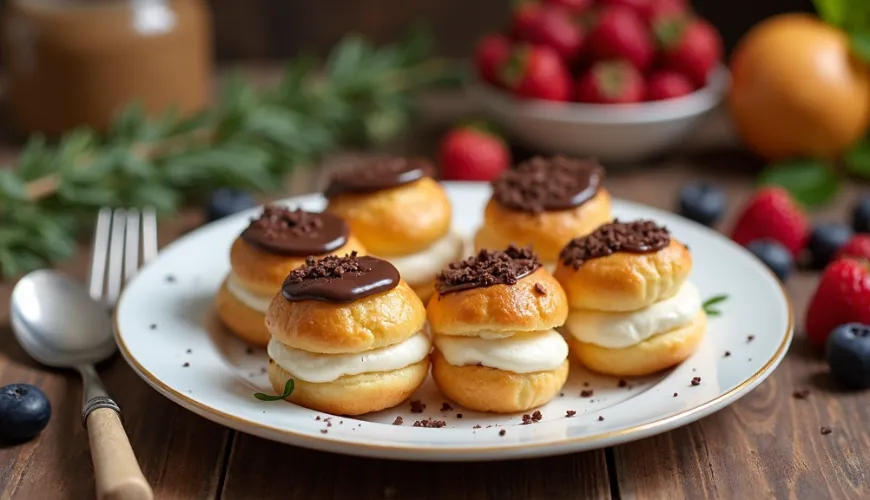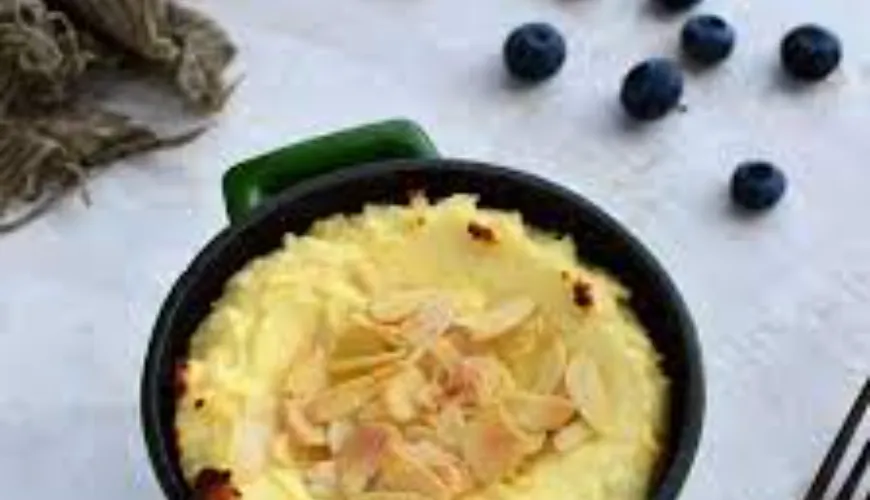
Tips and Tricks for Perfect Choux Pastry at Home

The Secret of Choux Pastry - What Makes It Light, Fluffy, and Versatile?
Éclairs, cream puffs, profiteroles, and even savory bites filled with cheese mousse. What do they have in common? One dough – choux pastry. At first glance, it may seem complicated, but once you understand its principle, it becomes an unexpected ally in festive baking and preparing unconventional treats. Choux pastry is not just a matter for patisserie displays — you can easily make it at home.
What exactly makes choux pastry so special? What is its magic, and why are we so afraid it might "fail"?
How Is Choux Pastry Made and Why Is It So Different?
Unlike other doughs, where dry and wet ingredients are combined cold, choux pastry is prepared hot. The base consists of water (or milk), fat, flour, and eggs. First, bring the water and fat to a boil, then stir in the flour and "cook" the mixture – cooking and stirring until a compact mass forms that does not stick to the sides of the pan. The name derives from this process, as the dough is literally "fired off" from the container.
Once cooled, eggs are gradually beaten into the dough, giving it elasticity, lightness, and the ability to rise beautifully during baking. The result is a silky-smooth yet firm dough that holds its shape when piped onto a baking sheet and has enough moisture to create typical pockets in the oven. These are perfect for filling with creams, whipped cream, or savory mousses.
The Best Choux Pastry Is About Technique, Not Luck
Many home bakers are wary of choux pastry. They fear it will collapse, not rise, or remain raw inside. The truth is, the best choux pastry does not happen by chance – it just requires a bit of patience and a few tried-and-tested tricks.
One of the most common problems is insufficient "cooking off." This step should not be rushed – the dough needs to be thoroughly mixed over low heat so that the flour is well cooked and some of the water evaporates. The result should be a cohesive mass that leaves a light film at the bottom of the pan. If this step is skimped, the dough may be too runny and lose shape during baking.
Another crucial phase comes when adding the eggs. Eggs should be incorporated gradually, ideally one at a time, to control the consistency. The finished dough should be smooth, shiny, and form a "hook" when lifted with a spoon – this is a sign of the correct thickness. If the dough is too fluid, the éclairs will spread out. If it's too thick, they won't rise and will remain dense.
The correct baking technique is then the final step to success. The key is a sufficiently preheated oven, ideally at 200–220 °C, so that moisture quickly evaporates from the dough and the typical "puffed" shape forms. Never open the oven during the first 20 minutes – the dough could fall and not rise again.
Choux Pastry for Éclairs - A Recipe That Stands the Test Even with Grandma
If there is a dessert that evokes festive Sundays, it is éclairs from choux pastry. They are perfect for testing how the dough works and what it can achieve.
Classic Choux Pastry Recipe for Éclairs:
- 250 ml of water
- 100 g of butter
- 150 g of all-purpose flour
- 4 eggs
- a pinch of salt
Place the water, butter, and salt into a pot and bring to a boil. Once the butter melts, add the flour all at once and start stirring vigorously. The dough will seem lumpy at first, but after a while, it will bind, thicken, and start peeling away from the sides. Cook and stir for about 2–3 minutes until a compact mass forms. Then allow it to cool slightly (just a few minutes) and gradually add the eggs – one by one, thoroughly beaten in.
Transfer the finished dough into a piping bag with a star tip and pipe éclairs onto a baking sheet lined with parchment paper. Bake in a preheated oven at 210 °C for about 25 minutes until golden. After baking, let them cool well before filling – perhaps with vanilla cream, whipped cream, or pudding buttercream.
Interestingly, in some families, éclairs are baked during holidays as an alternative to cake. Mrs. Marie from Plzeň recalls: "Our grandmother made éclairs for every birthday. She always said that cake is too heavy and time-consuming, but éclairs can even be made by a grandchild. And she was right."
What Can Be Made from Choux Pastry?
Although most people associate choux pastry with sweets, its possibilities are much broader. In gastronomy, it is also used for savory dishes – for example, cheese puffs called gougères, which are popular in France with wine.
The dough is also used for popular Spanish churros, which are prepared similarly but fried in oil and coated with sugar. In Italy, similar dough is used to make zeppole, and in Poland, pączki from parzonego ciasta. Everywhere, the technique of cooking off plays a leading role.
From a practical perspective, choux pastry is also suitable for preparing sugar-free dishes – for example, gluten-free variants or desserts with limited sweeteners. This makes it an ideal base for healthier cooking – for example, with whole-wheat flour or vegetable fat.
Why Is It Worth Learning Choux Pastry?
In today's world, where people are rediscovering the charm of home baking and seeking recipes that are not only tasty but also versatile, choux pastry is perfect. With one recipe, you can create dozens of variations, which can be adapted according to mood, season, or dietary needs.
Moreover, it is a dough that is suitable for freezing – although unprepared, it is difficult to store, so it is better to freeze already baked and dry shells. After defrosting, they only need filling and possibly a short bake.
And most importantly – success with choux pastry gives a person a certain patisserie confidence. Suddenly, a world of homemade éclairs, éclairs, mini éclairs for celebrations, or savory pastries for parties opens up. And that is definitely worth a bit of practice.
As with all traditional recipes, quality ingredients make a difference. Butter instead of cheap margarine, fresh eggs, and good flour are the foundation of success.
Choux pastry is like a magical canvas – seemingly inconspicuous, but with immense potential. Whether you use it for festive éclairs or savory bites with herb cream, it will surely impress. Just try it once, and it will quickly become a staple in your repertoire.

